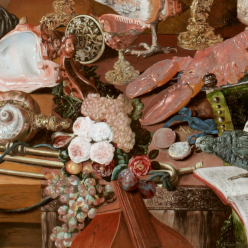
c. 1496
colored woodcut – print
25.7 x 9.7 cm
Staatliche Museen du Berlin
This woodcut by Dürer from the beginning of the outbreak of a mysterious venereal disease at the turn of the 15th/16th centuries accompanies a popular new form of literature that emerged at the time: syphilis poetry. Dürer’s Syphilitic Man appears with a poem by Theodore Ulsenius.
The imaginative possibilities of poetry highlighted the devastation that syphilis wrought on Europe before (and after) it was firmly understood that syphilis was a sexually-transmitted disease. The representations of astrological signs at the top of the woodcut signify a planetary event that occurred in 1484 that many intellectuals at the time attributed to the outbreak of the disease. Scorpio, in particular, was associated with the genital sphere.
The most famous poem to come out of this moment was Girolamo Fracastoro’s Syphilis, or the French Disease (1530), which gave the affliction its contemporary name. Fracastoro relates the horrors of “pustules with an acorn-cup and rotten with thick slime, which soon afterwards gaped wide open and flowed with a discharge like mucous and putrid blood.”* Syphilis (Treponema pallidum), even in its significantly less virulent contemporary form, can permanently disfigure or even kill its host. Beyond the presence of painful ulcers and ‘gummy’ tumors, syphilis – when contracted in pregnant women – can induce miscarriages and has a high rate of fatal transmission to infants.
The horrors of syphilis produced many interesting effects on society. Unlike most alarming outbreaks, the fear surrounding syphilis did not result in trends of violence against minority communities. Some scholars have speculated that syphilis contributed to a rise in witchcraft hysteria. However in large part, as noted in Fracastoro’s full title, syphilis became attributed to whole nations of people. Particularly once 16th century physicians understood its venereal nature, syphilis became associated with low moral standing, and thus the inferiority of other peoples.
Syphilis was most commonly referred to as the French Disease, as several reports attributed its origin to the French wars in Italy. Contemporary scholars are still undecided on its real origins, though most suspect that it came over from the New World with Columbus’ return voyage. The ‘French’ epithet was not universal: in France it was known as the ‘Neopolitan evil;’ in the Netherlands, the ‘Spanish pox;’ in Central Asia it was deemed Russian; and in East Asia it was known as the ‘Portuguese disease.’ Thus syphilis poetry marks an interesting shift in collective identity.
* Fracastoro, Syphilis, or the French Disease, 55.
Sources:
Cummins, J.S.. “Pox and Paranoia in Renaissance Europe.” History Today, Vol. 38 Issue 8. August 1988.
Fracastoro, Girolamo. Syphilis, or the French Disease, trans. Geoffrey Eatough. Liverpool: Francis Cairns, 1984.
Knell, Robert J.. “Syphilis in Renaissance Europe: rapid evolution of an introduced sexually transmitted disease?” Proceedings Biological Sciences Vol. 271, No. 4. May, 2004.
Ross, Eric B. “Syphilis, Misogyny, and Witchcraft in 16th Century Europe.” Current Anthropology, Vol. 36, No. 2. Apr., 1995.
Image from: Artstor. “The Syphilitic Man (The French Disease) [Der Syphilitiker].” Artstor Digital Library. Accessed Dec. 6th, 2018. https://library.artstor.org/#/asset/BERLIN_DB_10313749275;prevRouteTS=1544122609535

